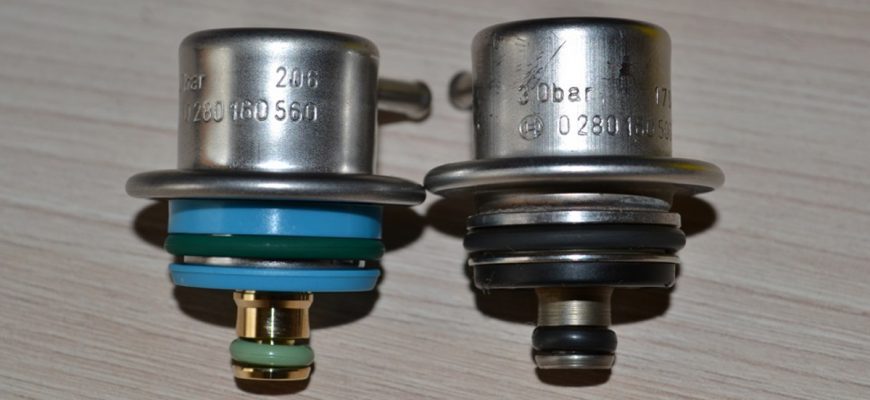
The principle of operation and the device of the fuel pressure regulator
Content
The device of modern diesel and gasoline power units may differ depending on the fuel system that the manufacturer uses on its cars. One of the most progressive developments of this system is the Common Rail fuel rail.
In short, the principle of its operation is as follows: a high-pressure fuel pump (read about its device here) supplies diesel fuel to the rail line. In this element, the dose is distributed among the nozzles. The details of the system have already been described. in a separate reviewbut the process is regulated by the ECU and the fuel pressure regulator.
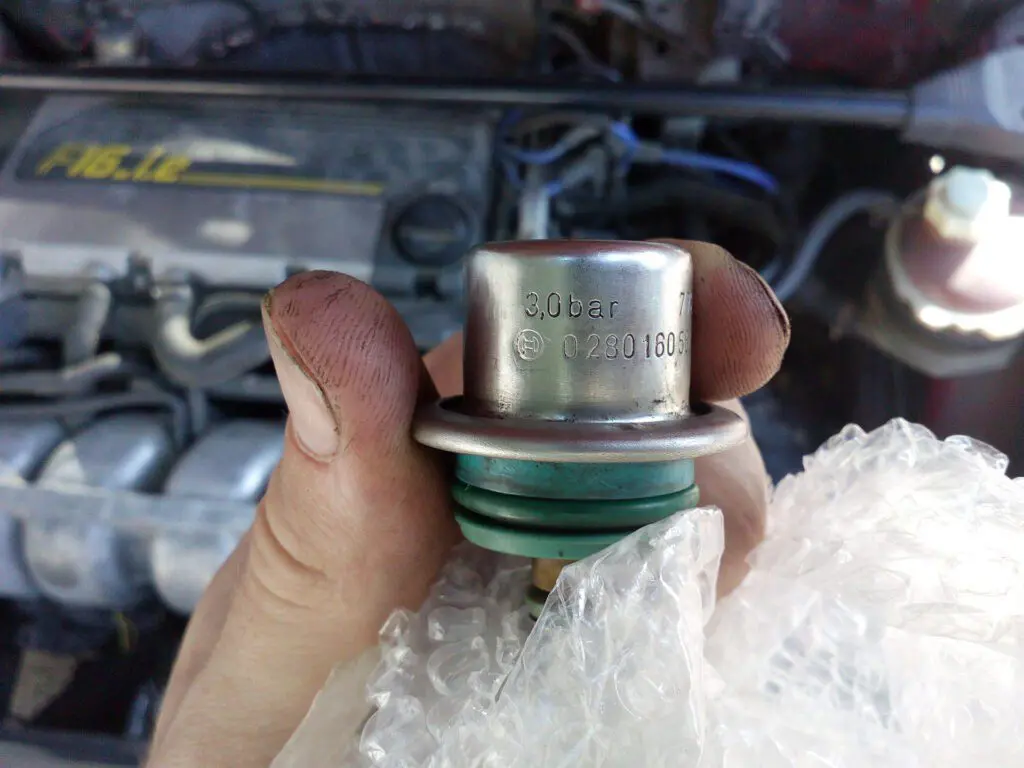
Today we will talk in more detail about this part, as well as about its diagnosis and the principle of operation.
Fuel pressure regulator functions
The function of the RTD is to maintain the optimal fuel pressure in the engine injectors. This element, regardless of the intensity of the load on the unit, maintains the required pressure.
When the engine speed increases or decreases, the amount of fuel consumed can either increase or decrease. To prevent the formation of a lean mixture at high speeds, and too rich at low speeds, the system is equipped with a vacuum regulator.
Another benefit of the regulator is the compensation of overpressure in the rail. If the vehicle was not equipped with this part, the following would occur. When less air flows through the intake manifold, but the pressure remains the same, the control unit would simply change the fuel atomization time (or the already finished VTS).
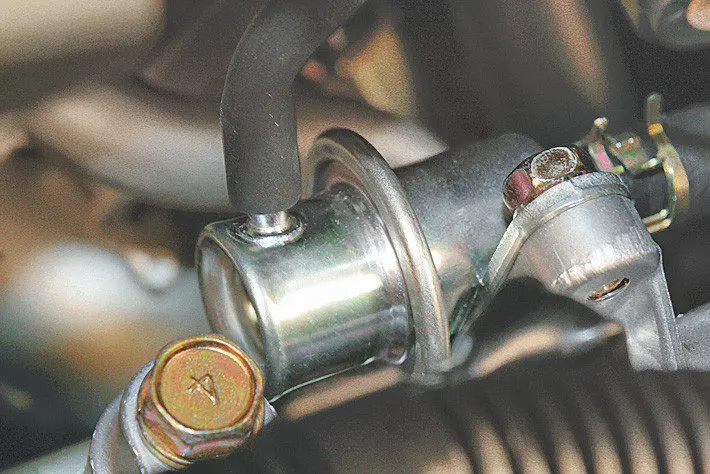
However, in this case, it is not possible to fully compensate for the excessive head. The surplus fuel must still go somewhere. In a gasoline engine, excess gasoline will flood the candles. In other cases, the mixture will not completely burn, which will cause particles of unburned fuel to be removed into the exhaust system. This significantly increases the "gluttony" of the unit and reduces the environmental friendliness of automobile exhaust. The consequences of this can be very different - from strong soot while driving to a broken catalyst or particulate filter.
The principle of operation of the fuel pressure regulator
The fuel pressure regulator works according to the following principle. The high-pressure pump creates a pressure, the fuel flows through the line to the ramp, in which the regulator is located (depending on the type of vehicle).
When the volume of the pumped fuel exceeds its consumption, the pressure in the system rises. If it is not thrown off, sooner or later the circuit will break at the weakest link. To prevent such a breakdown, a regulator is installed in the rail (there is also a location in the gas tank), which reacts to excessive pressure and opens a branch to the return circuit.
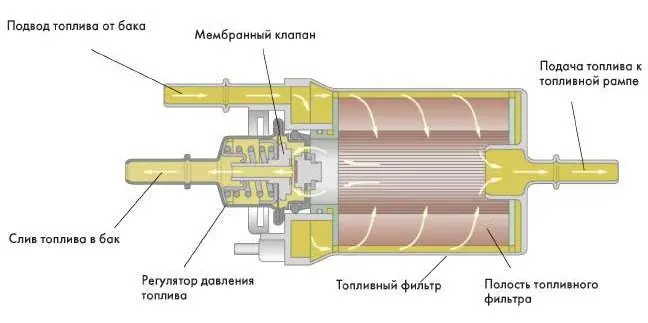
Fuel seeps into the fuel system hose and flows back into the tank. In addition to relieving excess pressure, the RTD responds to the vacuum that is created in the intake manifold. The higher this indicator is, the less pressure the regulator will withstand.
This function is necessary so that the engine uses less fuel while running at minimum load. But as soon as the throttle valve opens more, the vacuum decreases, which makes the spring stiffer and the pressure increases.
Устройство
The design of classic regulators consists of the following parts:
- Strong metal body (must have perfect tightness, as it is faced with a change in fuel pressure);
- The inner part of the body is divided into two cavities by a diaphragm;
- To keep the fuel pumped into the rail in it, a check valve is installed in the body;
- A rigid spring is installed under the diaphragm (in the part where there is no fuel). This element is selected by the manufacturer in accordance with the modification of the fuel system;
- There are three fittings on the body: two for connecting the supply (inlet to the regulator and outlet to the nozzles), and the other for the return;
- Sealing elements for sealing the high pressure fuel system.
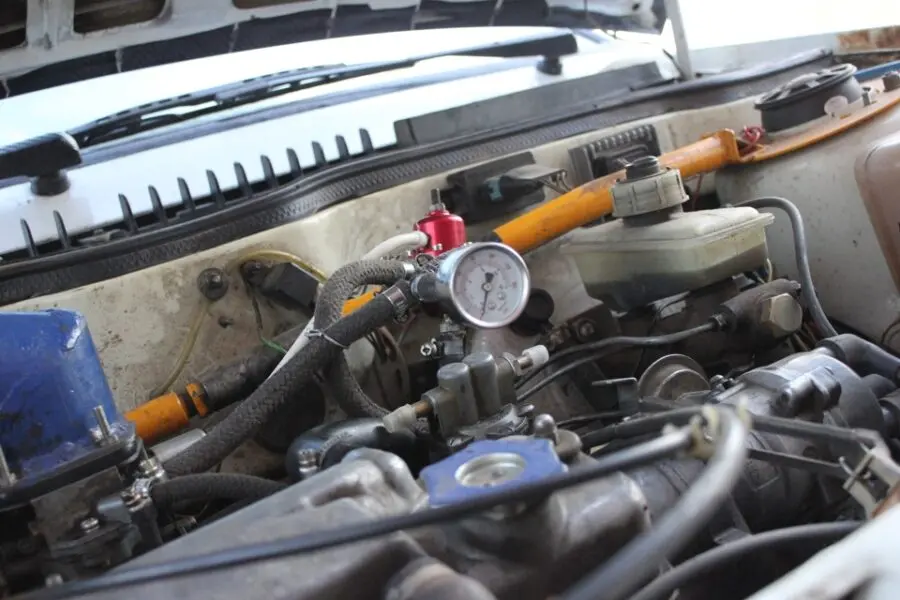
The general principle of RTD operation was described a little above. In more detail, it functions like this:
- The high-pressure fuel pump pumps fuel into the rail;
- The injectors open in accordance with a signal from the control unit;
- At low speeds, the cylinders do not need a lot of fuel, so the ECU does not initiate a strong opening of the injector nozzles;
- The fuel pump does not change its mode, therefore, excessive pressure is created in the system;
- The pressure drives the spring-loaded diaphragm;
- The circuit opens for dumping fuel back into the tank;
- The driver presses the gas pedal;
- The throttle opens harder;
- The vacuum in the intake manifold decreases;
- Additional resistance is created to the spring;
- It is more difficult for the diaphragm to maintain this resistance, so the contour overlaps to some extent (depending on how hard the pedal is depressed).
In some modifications of fuel systems with the supply of a combustible mixture under pressure, an electronic valve is used instead of this regulator, the operation of which is controlled by an ECU. An example of such a system is the Common Rail fuel rail.
Here is a short video on how this element works:
Location in the vehicle structure
A modern car in which such a device will be installed can use one of two regulator layouts:
- The fuel supply line is equipped with a return line. In this case, the regulator, or valve, will be installed on the fuel rail. A supply hose will be fixed at the valve inlet (at one end there is an inlet from the pump, and on the other - an outlet to the nozzles), and at the outlet, a return loop hose is connected;

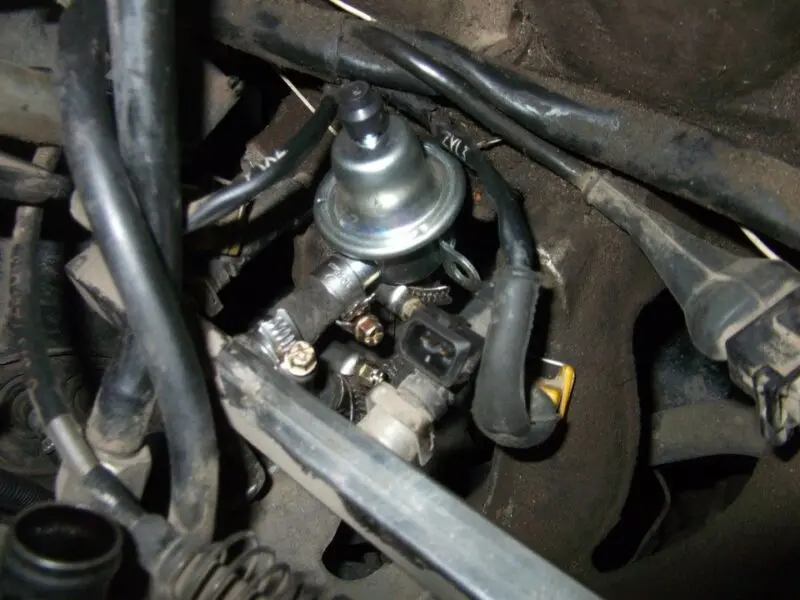
- Line without recirculation. In this case, the regulator is installed next to the fuel pump in the gas tank (often included in its design). Its operation is regulated either by an ECU or by the mechanism of the pump itself. The fuel is discharged in the tank itself.

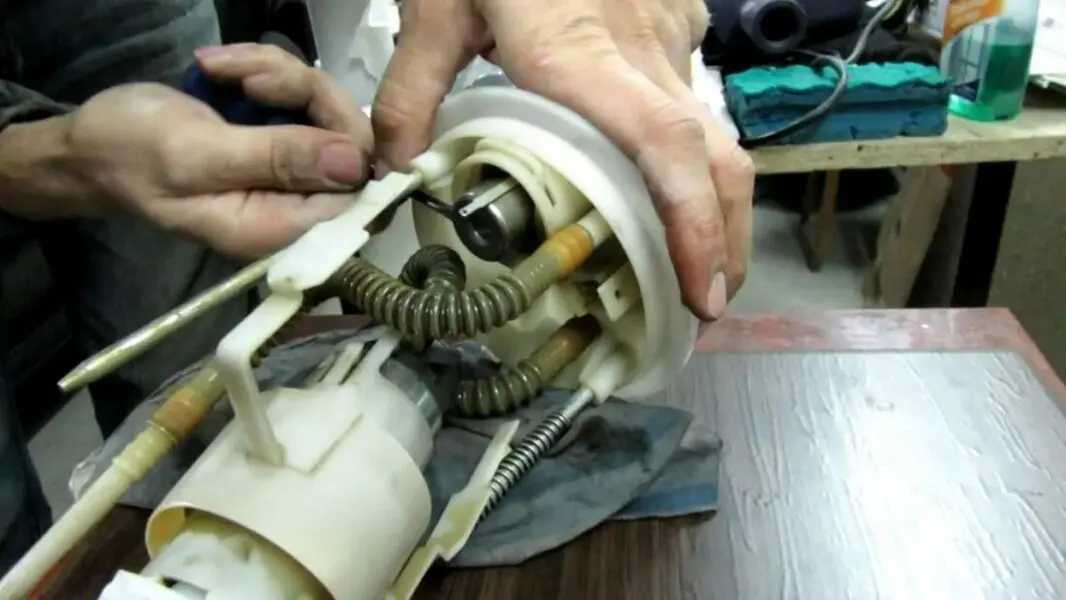
The first scheme has several disadvantages. Firstly, when the unit is depressurized, gasoline or diesel fuel will pour into the engine compartment. Secondly, unused fuel is unnecessarily heated and returned to the gas tank.
For each engine model, its own regulator modification is created. In some cars, you can use a universal RTD. Such models can be manually adjusted and equipped with a pressure gauge. They can be used as an alternative to the standard regulator that is installed on the ramp.
Diagnostics and malfunctions of the fuel regulator
All regulator modifications are non-separable, so they cannot be repaired. In some cases, the part can be cleaned, but its resource does not greatly increase from this. When a part breaks down, it is simply replaced with a new one.
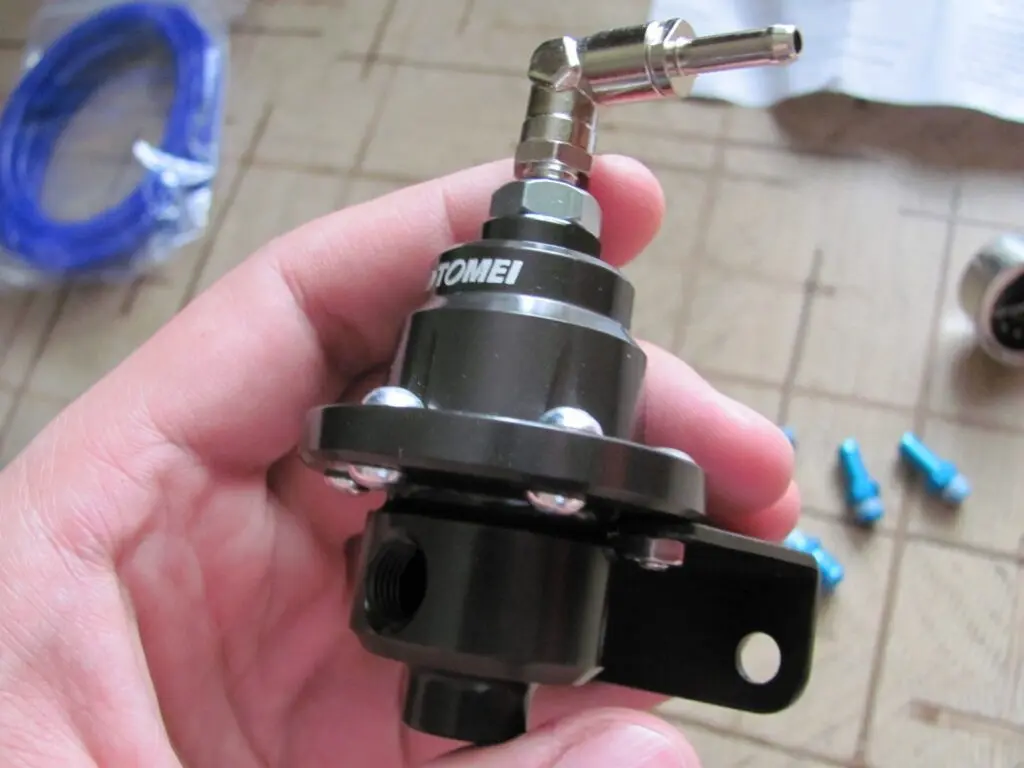

Here are the main reasons for failure:
- The spring has broken;
- Formation of a fistula in the body (often due to exceeding the pressure threshold or mechanical damage);
- Natural wear of moving parts;
- Corrosion formation;
- Clogged channels.
When diagnosing the device, it should be remembered that some of the symptoms are similar to the failure of the injection pump. It is also not uncommon for the fuel system to malfunction, the symptoms of which are very similar to a breakdown of the regulator. An example of this is clogged filter elements.
In order for this element to work out its assigned resource, it is very important to pay attention to the quality of the fuel used.
How to check the fuel pressure regulator?
There are several easy methods to check the fuel regulator. But before considering them, let's pay attention to the symptoms that directly or indirectly may indicate a malfunction of the RTD.
When to check the pressure regulator?
Difficulty starting the engine may indicate a faulty governor. Moreover, for some car models this happens after the engine is idle (cold start), while for others, on the contrary, for a hot one.
Sometimes there are situations when, in the event of a malfunction of a part, a message about the engine emergency mode is displayed on the instrument panel. However, this is not the only breakdown that activates this mode.


On some cars, a signal with a heating coil periodically appears on the dashboard during a trip. But in this case, before replacing the part, it will be necessary to diagnose it.
Indirect signs include:
- Uneven operation of the unit;
- The car stalls at idle;
- The crankshaft speed increases or decreases sharply;
- A noticeable decrease in the power characteristics of the motor;
- There is no response to the gas pedal or has significantly deteriorated;
- When shifting to an overdrive, the car loses a lot of dynamics;
- Sometimes the work of the internal combustion engine is accompanied by jerks;
- The "gluttony" of the car has noticeably increased.
Checking the pressure regulator on the bench
The easiest diagnostic method is to take the car to a service that uses diagnostic stands. To check you will need:
- Remove the fuel rail along with the RTD;
- All contacts and hoses are connected to the module at the stand;
- The device simulates the operation of the motor in different modes, while measuring all the parameters.
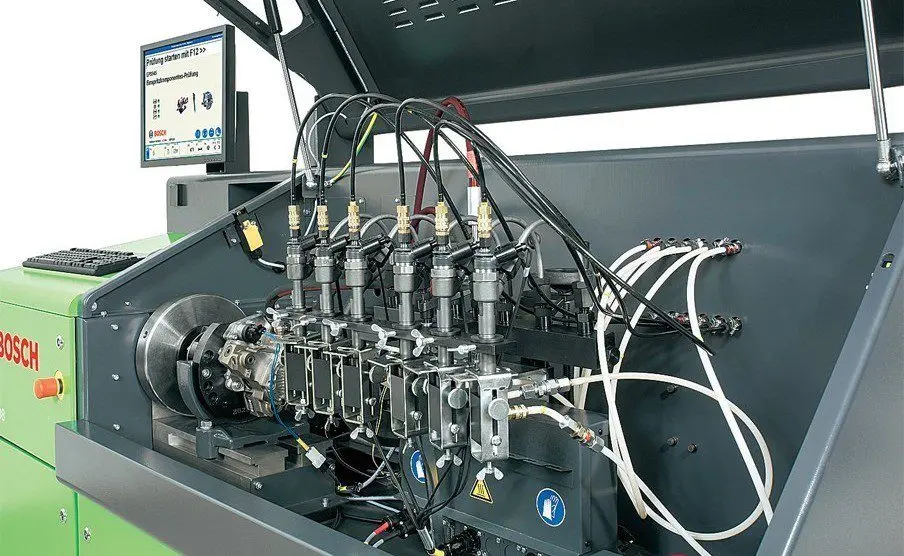

Different algorithms are installed in the stand program, according to which the serviceability of the regulator is determined. Such programs are used only by service centers, therefore, it is impossible to carry out this diagnostic procedure without visiting a service station.
Checking the regulator without removing it from the car
It must be remembered that not in all cases there is such a possibility., But if the device of the car allows you to get to the regulator without major dismantling work, then the procedure can be performed as follows:
- First, a visual inspection is carried out. It will be difficult not to notice the depressurization of the case. The same procedure will help identify any mechanical damage, as well as the formation of rust;
- Disconnect the vacuum hose, and install a pressure gauge between the supply connection and the fuel hose. We start the engine. If the device shows a stable pressure, then the regulator is faulty. The arrow indicator should vary from 0,3 to 0,7 atm .;

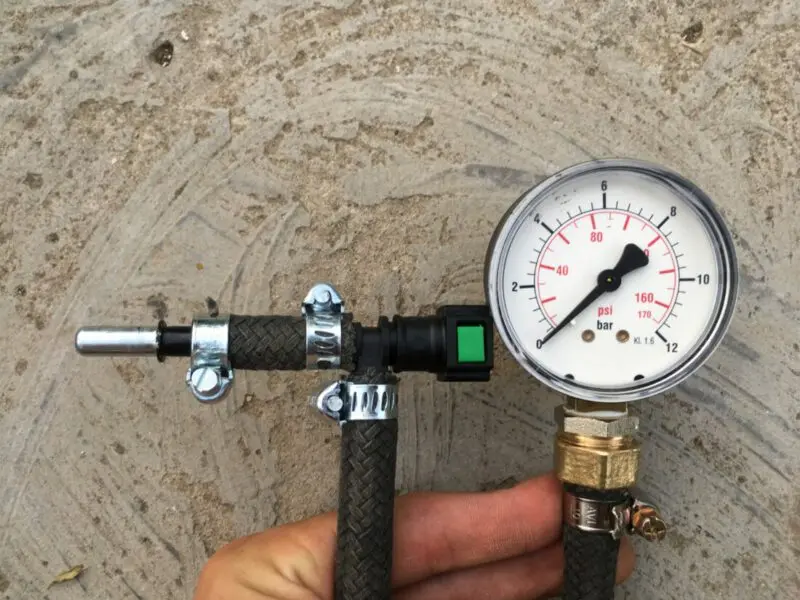
- Another method is to pinch the return hose. The pressure gauge is installed according to the previous scheme. The indicator of the device should immediately jump. The same procedure can be carried out without a pressure gauge. We just start the engine, squeeze the return line and listen to how the unit works. If its operation has stabilized, then the regulator needs to be replaced.
Checking the regulator by substitution method
This is the surest way to make sure a part is defective. In this case, we remove the diagnosed element, and instead of it we install a known-good analogue.
If diagnostics are not carried out in a timely manner, the motor can be seriously damaged. If not a unit, then some important element of the fuel supply system will definitely fail. And this is an unjustified waste.
Possible causes of failure
Possible causes of damage to the fuel pressure regulator include:
- The car was idle for a long time, and the fuel system was not used;
- Water has entered the fuel (condensation is natural in some operating conditions);
- The spring is loose;
- The membrane is damaged;
- Check valve stuck or worn out;
- The car owner does not change fuel filters on time;
- The driver fills with low-quality fuel (the valve is clogged).
If there is any suspicion of a malfunction of the fuel regulator, it should be checked. As we have already said, for this you can use a simple pressure gauge (even one that measures the pressure in the wheel tires is suitable).
How to replace a regulator?
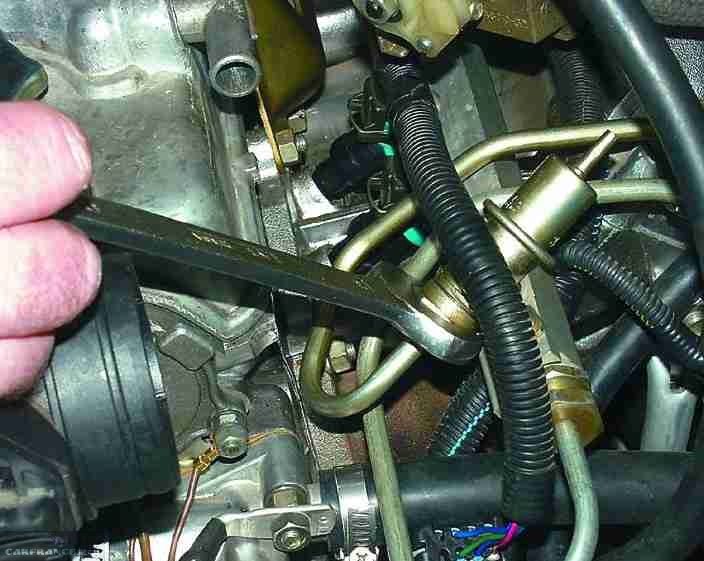

The procedure for replacing the fuel pressure regulator is simple. The main thing is to adhere to the following scheme:
- At the end part, the union plug is unscrewed. An O-ring is installed in it. In a working regulator, this element is elastic and without damage. If inconsistencies are revealed during the inspection, then the part changes or the entire cork;
- The umbrella is turned out of the fitting. To do this, you need a cap from the tire (in the metal version there are clips that will help with this);
- Next, the regulator is checked in operation. A hose with a pressure gauge at the other end is connected to the regulator. It is fixed with a clamp. The internal combustion engine is started and the pressure in the system is checked. At this moment, the indicator should be in the range from 284 to 325 kPa. Next, the hose is disconnected from the device, and the readings on the pressure gauge are checked. In this case, the head should increase by approximately 20-70 kPa. If this parameter has not changed, then the regulator is faulty, and then it is replaced;
- To replace the regulator, you must first reduce the fuel pressure in the system. This is done by unscrewing the nut that secures the fuel pipe. It is also necessary to unscrew the two bolts that fix the regulator itself to the ramp;
- The regulator fitting is carefully removed from the fuel rail;
- The fuel pipe is disconnected (if the system has not yet released the pressure, you need to prepare an empty container, into which the released end of the pipe is quickly placed);
- The regulator can now be removed.
When a new fuel pressure regulator is installed, the fittings of the pipes and sealing elements must be pre-moistened with gasoline so that the elastic parts do not receive mechanical damage.
Questions and answers:
How to check the fuel pressure regulator. The first way is to dismantle the fuel rail. It allows you not only to make sure that the regulator is in good working order, but also in other elements of the fuel system. To perform this check, you will need special equipment. The old-design regulator is checked by short-term shut-off of the fuel return line. This method is available for gasoline engines. It is better to do work on a cold engine. If the return line, squeezed for a few seconds, helped to eliminate the triplet of the motor and stabilized its operation, then the pressure regulator needs to be replaced. It is not worth keeping the line clamped for a long time, as this will affect the serviceability of the fuel pump. This method is not available for car models that use a metal line. Another way to use an electronic fuel pressure regulator is with a multimeter set to voltmeter mode. The regulator chip is disconnected. We ground the black probe, and connect the red one to the chip leg. With a working regulator, the voltage should be around 5 volts. Next, we connect the red probe of the multimeter to the positive terminal of the battery, and connect the black one to the negative leg of the chip. In good condition, the indicator should be within 12V. Another way is with a pressure gauge. In this case, the vacuum hose is disconnected, and the device itself is connected between the fitting and the fuel hose. For a gasoline unit, a pressure of 2.5-3 atmospheres is considered the norm, but this parameter must be clarified in the technical literature for the car.
How to trick the fuel pressure sensor. To do this, you should use the services of service centers that perform chip tuning of cars. They may offer to buy a tuning box that connects to the car's control unit. But in this case, it is worth clarifying whether the "snag" will be recognized by the control unit as incorrect operation of the fuel system or not. If the ECU does not accept the non-standard device, then algorithms will be activated in it, which will create processes bypassing the operation of the tuning box.
What happens if you turn off the fuel pressure sensor. If you do this with the engine running, it will not affect its operation. But if the fuel pressure sensor is off, the engine will not start.